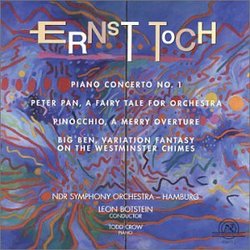| All Artists: Hamburg Symphony Orchestra, Ernst Toch, Leon Botstein, Todd Crow Title: Toch: Piano Concerto No. 1, Peter Pan Members Wishing: 0 Total Copies: 0 Label: New World Records Release Date: 11/26/2002 Genre: Classical Style: Symphonies Number of Discs: 1 SwapaCD Credits: 1 UPC: 093228060925 |
Search - Hamburg Symphony Orchestra, Ernst Toch, Leon Botstein :: Toch: Piano Concerto No. 1, Peter Pan
 | Hamburg Symphony Orchestra, Ernst Toch, Leon Botstein Toch: Piano Concerto No. 1, Peter Pan Genre: Classical
Ernst Toch (1887?1964) was one of the many talented German composers who emigrated to the United States before the onset of World War II and subsequently reestablished their careers here. This recording of four previously ... more » |
Larger Image |
CD Details
Synopsis
Album Description
Ernst Toch (1887?1964) was one of the many talented German composers who emigrated to the United States before the onset of World War II and subsequently reestablished their careers here. This recording of four previously unavailable orchestral works will undoubtedly contribute to the continuing reassessment of his Toch?s masterfully crafted and inspired music. Toch?s atonality in the Piano Concerto (1926) was cutting-edge for its day and sounds today more like a work of the 1940s. Although he never adopted twelve-tone technique to any great extent, he developed a well-defined strategy for writing atonal music in a listenable and lively way. The music is very chromatic, running for long stretches at a time without referring to any tonal center, but the melodic contours are smooth and clear, and the rhythms full of propulsive energy. Peter Pan (1956) is not so different in style, but shows tremendous advances in orchestrational sophistication. An airy, immaterial piece as befits its subject matter, one might consider it Mendelssohnian, or perhaps a modern companion piece to Berlioz?s "Queen Mab" Scherzo. The leaping melodies in the strings and winds are remarkable for their lithe abandon and their quasi-twelve-tone avoidance of pitch repetition. The similarly fairy-tale-inspired Pinocchio (1935) is more harmonically conventional-sounding, with melodies that seem Bartókian, and surprise cadences that call Prokofiev to mind. Touches deliberately reminiscent of the nineteenth century are found, including a waltz and martial figures of pentatonic melody. It is the Big Ben Variations, though, that remains Toch?s best-known work (aside from the inventive Geographical Fugue based on exotic place names, beloved of choruses). This is a compositional tour de force: a set of variations on the familiar chimes of Westminster Abbey. Here as in the other works the orchestration is feather-light, never bombastic or pompous. The chime theme is heard punctuating chromatic melodies; hiding in the timpani; serving as cadences for long, wandering chorales; hiding in accompaniment patterns; even warped into an almost twelve-tone fugue subject. It is not your standard theme and variations, but the unprecedented product of a well-developed! musical mind.

 Track Listings (4) - Disc #1
Track Listings (4) - Disc #1